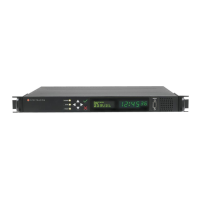Table 2-5:
System Time Message field descriptions
Data
Name
Data Description Range Resolution Units
Message
ID
UID of the message; programmable Unsigned 32 bit
integer
1 n/a
Message
Size
Total message size in bytes Unsigned 32 bit
integer
1 Bytes
Seconds Seconds since epoch (00:00:00 Jan 1,
1970 UTC)
Unsigned 32 bit
integer
1 Seconds
NSec NSec within the current second Unsigned 32 bit
integer
1 nsec
EOM End-of-message -1 1 n/a
2.15 Configuring NTP
Network Time Protocol (NTP) and Simple Network Time Protocol (SNTP) are client-server pro
tocols that are used to synchronize time on IP networks. NTP provides greater accuracy and bet
ter error checking capabilities than SNTP does, but requires more resources.
For many applications, it is not necessary to modify the NTP factory default configuration set
tings. It is possible, however, to change most of the settings in order to support specific NTP
applications which may require a non-standard configuration:
These features include the ability to use either MD5 authentication or NTP Autokey, to block
NTP access to parts of the network and to broadcast NTP data to the network’s broadcast
address. NTP and SNTP are used to synchronize time on any computer equipment compatible
with the Network Time Protocol. This includes Cisco routers and switches, UNIX machines, and
Windows machines with suitable clients. To synchronize a single workstation, several freeware
or shareware NTP clients are available on the Internet. The software running on the PC determ
ines whether NTP or SNTP is used.
When the NTP service is enabled, SecureSync will “listen” for NTP request messages from NTP
clients on the network. When an NTP request packet is received, SecureSync will send an NTP
response time packet to the requesting client. Under typical conditions, SecureSync can service
several thousand NTP requests per second without MD5 authentication enabled, and at a some
what lower rate with MD5 authentication enabled.
You can either enable or completely disable the NTP Service. When NTP is disabled, no NTP
time packets will be sent out to the network. When enabled, by default, the NTP Service oper
ates in Unicast mode, i.e. the NTP Service responds to NTP requests only.
Note: In order to configure NTP, you need to access the NTP Setup screen which
requires ADMINISTRATORrights.
2.15 Configuring NTP
CHAPTER 2 • SecureSync User Reference Guide Rev. 23
89

